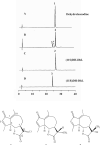The effect of dehydroleucodine in adipocyte differentiation
- PMID: 21963454
- PMCID: PMC3401420
- DOI: 10.1016/j.ejphar.2011.09.033
The effect of dehydroleucodine in adipocyte differentiation
Abstract
Dehydroleucodine (DhL) is a sesquiterpene lactone of the guaianolide group with gastric cytoprotective activity. Recent studies have also demonstrated that DhL inhibits the proliferation of vascular smooth muscle cells. In this study we examined the effect of DhL in the differentiation of 3T3-L1 preadipocytes. The addition of DhL significantly inhibited the differentiation of 3T3-L1 preadipocytes along with a significant decrease in the accumulation of lipid content by a dramatic downregulation of the expression of adipogenic-specific transcriptional factors PPARγ and C-EBPα. However, phosphorylation of AMPKα, Erk1/2 and Akt1 was not inhibited by DhL treatment. Interestingly, we also found that 11,13-dihydrodehydroleucodine, a derivative of DhL with inactivated α-methylene-γ-lactone function, also inhibited the differentiation of 3T3-L1 preadipocytes. Taken together, these data suggest that DhL has an important inhibitory effect in cellular pathways regulating adipocyte differentiation by modulating the PPARγ expression, which is known to play a pivotal role during adipogenesis.
Copyright © 2011 Elsevier B.V. All rights reserved.
Figures






References
-
- Auld CA, Hopkins RG, Fernandes KM, Morrison RF. Novel effect of helenalin on Akt signaling and Skp2 expression in 3T3-L1 preadipocytes. Biochem. Biophys. Res. Commun. 2006;346:314–320. - PubMed
-
- Beekman AC, Woerdenbag HJ, van Uden W, Pras N, Konings AW, Wikstrom HV, Schmidt TJ. Structure-cytotoxicity relationships of some helenanolide-type sesquiterpene lactones. J. Nat. Prod. 1997;60:252–257. - PubMed
-
- Blanco JG, Gil RR, Alvarez CI, Patrito LC, Genti-Raimondi S, Flury A. A novel activity for a group of sesquiterpene lactones: inhibition of aromatase. FEBS. Lett. 1997;409:396–400. - PubMed
-
- Bohlmann F, Zdero C. Zwei neue Sesquiterpen-lactone aus Lidbeckia pectinata Berg. und Pentzia elegans DC. Tetrahedron Lett. 1972;13:621–624.
-
- Bost F, Aouadi M, Caron L, Binetruy B. The role of MAPKs in adipocyte differentiation and obesity. Biochimie. 2005;87:51–56. - PubMed
Publication types
MeSH terms
Substances
Grants and funding
LinkOut - more resources
Full Text Sources
Miscellaneous

